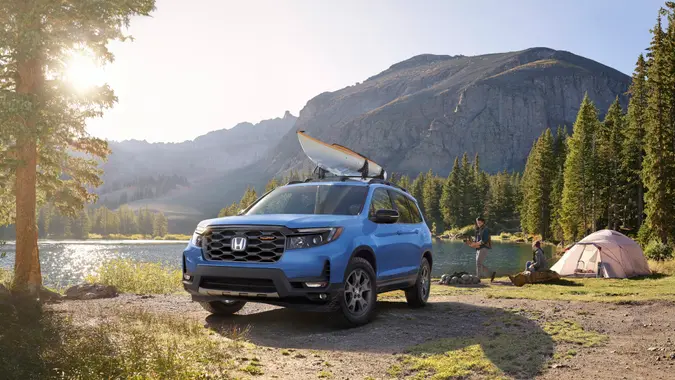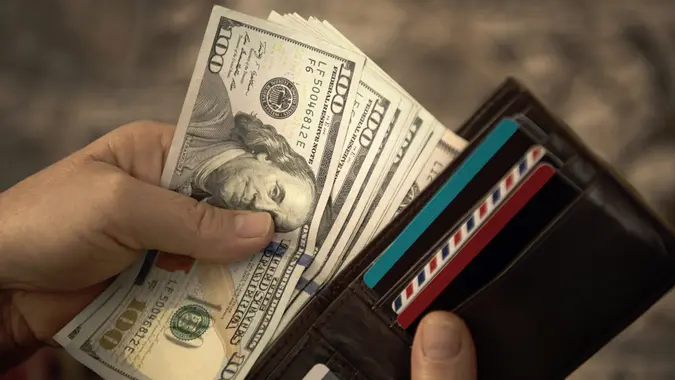Auto Experts: 6 Car Fixes You Can Do at Home That Will Save You Hundreds

Commitment to Our Readers
GOBankingRates' editorial team is committed to bringing you unbiased reviews and information. We use data-driven methodologies to evaluate financial products and services - our reviews and ratings are not influenced by advertisers. You can read more about our editorial guidelines and our products and services review methodology.

20 Years
Helping You Live Richer

Reviewed
by Experts

Trusted by
Millions of Readers
Most people know the flash of dread you get when the little light of doom comes on in your car, signaling a problem. Car trouble typically means spending money that you weren’t expecting to.
But not all car problems require a professional’s touch, and learning how to DIY some common issues can save you big money. Here, auto experts recommend six car repairs you can do yourself that will save you hundreds, as well as ones you should not try at home.
Spark Plugs
Spark plugs, depending on the vehicle, typically require replacement every 20,000 to 40,000 miles, according to Matas Buzelis, an automotive expert and head of communications at carVertical. “Similar to regular oil changes, consistent maintenance is crucial, and the best part is that it’s a task that can be accomplished without extensive mechanical knowledge,” he said.
If you get your spark plugs changed at your car’s dealership or mechanic, it’s likely to cost between $300 and $500, he warned. “On the other hand, doing it yourself involves a cost ranging from $40 to $60 for four spark plugs, with basic tools adding up to around $30.”
Electronics
“Modern cars usually suffer from small yet irritating errors caused by faulty sensors or relays,” Buzelis said.
While the relays or sensors themselves are not cheap, replacing them is a straightforward task.
“Typically, relays are easily accessible, and the various types of sensors can be reached by unscrewing a part or two. This hands-on approach can also result in substantial savings for every sensor change, such as O2 or airbag sensors, ranging from $100 to $500,” he said.
Tire Pressure
Low tire pressure may not seem like an imminent car problem, but keeping your tires full is important to basic safety involving the braking, steering and handling of your car. Tire pressure also affects the fuel economy and tire life, according to Lauren Fix, sector analyst in automotive, energy and trends at The Car Coach.
You should check your tire pressure once a month to stay on top of this. “Always match the pressure in the tire with the correct pressure located on a sticker inside your driver’s door,” she said.
Check and Top Off Your Fluids
Your car relies on several different kinds of fluids to run and work properly, Fix said, including oil, coolant/anti-freeze, power steering, transmission and brake fluids.
Your owners’ manual should have the information you need on the type and amount of fluid your car needs for each of those categories, and they should be relatively easy to top off. If you have to change any of these fluids out, DIY videos online abound.
Replace Wiper Blades
Wiper blades are essential for maintaining visibility in rain, snow and fog. Fix said changing these out is easy to do yourself and very important to driving safely. “Remember, 80% of your driving decisions are based on visibility,” she stressed.
If you aren’t sure of the right blade type, Fix recommended to “switch to flat blades — they can be used year-round.” Additionally, most auto part stores will replace air filters, batteries and wiper blades free of charge when you purchase them, she said.
Air Filter Replacement
A straightforward process that requires no tools is to change your air filters, according to Michael Dominguez, auto expert and owner of Car Fixer Guide. Doing this increases fuel efficiency and reduces emissions, both of which contribute to a longer engine life.
What NOT To Fix Yourself
On the other hand, unless you are a trained mechanic, you should not try to handle certain types of car repairs. Here are a few key examples.
Don’t Do Your Own Brakes
Do not change your own brakes, Fix warned. “This should be performed by a pro — with anti-lock brakes and other safety features, you don’t want to take risks on safety and stopping.”
Don’t Make Engine and Transmission Fixes
Any major issues with your engine, transmission, bearings and bushings should be left to those who have the proper training, Fix said. “They are not beginner jobs.”
Don’t Make Safety Related Repairs
Other types of safety-related repairs to steer clear of doing yourself involve systems like SRS (airbags), ABS (braking), and ESP (stability), according to Benjamin Kovac, car mechanic and founder of the DIY repair blog, BeefyTools. “The risks involved with DIY repairs in these areas far outweigh the potential savings.”
Don’t Do Your Own Paint and Bodywork
There’s a common misconception that repainting damaged body parts is an easy and straightforward DIY task, Buzelis said. “However, it’s a complex undertaking that demands specific tools, knowledge of damage removal, and proper preparation for painting.”
Painting the bodywork, even just a single part, involves a steep learning curve, requiring both time and patience. Buzelis warned, “It might not be the wisest choice for your car, unless you’re unconcerned about its residual value and are open to experimentation.”
Knowing which fixes you can make by yourself, and which ones you can’t, will both save you money in the long run.
 Written by
Written by  Edited by
Edited by 

























